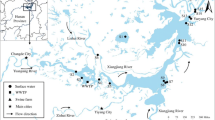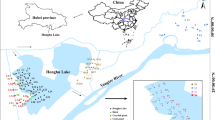Abstract
Background and purpose
Shrimp culture has been expanded rapidly in recent years in coastal wetland zone of Vietnam due to favorable natural conditions. However, this industry has caused several negative impacts to the environment. One of the critical issues is the excessive application of antibiotics including human medicines. These chemicals could be released from shrimp ponds and then accumulated and contaminated of the ecosystem. This review article discusses a whole range of findings that address various aspects of the usage, occurrence and potentially environmental risks of antibiotics released from shrimp farming, with emphasis on the South Vietnam coastal wetland.
Methods
The published information on the usage and occurrence of antibiotics in Vietnamese shrimp farming has been reviewed. A global comparison was also carried out. This follows by a brief overview of the transport and fate of these antibiotics in the environment.
Results
Several antibiotics commonly used in Vietnamese shrimp culture have been detected in wastewater and sediment of the ponds, as well as in surrounding coastal wetlands, resulting in the existence of antibiotic-resistant bacteria. However, their transport and fate could not be clearly defined.
Conclusions
The well-documented accumulation of antibiotics in mud and sediments in Vietnamese coastal wetlands potentially poses serious risks for the local wetland ecosystems. Thus, research on the transport and fate of antibiotics’ residues from the ponds into the surrounding environment is urgently needed.

Similar content being viewed by others
References
Akinbowale OL, Peng H, Grant P, Barton MD (2006) Antimicrobial resistance in bacteria isolated from aquaculture sources in Australia. J Appl Microbiol 100:1103–1113
Al-Ahmad A, Daschner FD, Kümmerer K (1999) Biodegradability of cefotiam, ciprofloxacin, meropenem, penicillin G and sulfamethoxazole and inhibition of waste water bacteria. Arch Environ Contam Toxicol 37:158–163
Alexy R, Kümpel T, Kümmerer K (2004) Assessment of degradation of 18 antibiotics in the closed bottle test. Chemosphere 57:505–512
Andreozzi R, Raffaele M, Nicklas P (2003) Pharmaceuticals in STP effluents and their solar photodegradation in aquatic environment. Chemosphere 50:1319–1330
Batt AL, Kim S, Aga DS (2007) Comparison of the occurrence of antibiotics in four full-scale wastewater treatment plants with varying designs and operations. Chemosphere 68:428–435
Björklund H, Rabergh CMI, Bylund G (1991) Residues of oxolinic acid and oxytetracycline in fish and sediments from fish farms. Aquaculture 97:85–96
Chee-Sanford JC, Mackie RI, Koike S, Krapac I, Maxwell S, Lin Y, Aminov RI (2009) Fate and transport of antibiotic residues and antibiotic resistance genetic determinants during manure storage, treatment, and land application. J Environ Qual 38:1086–1108
Chenxi W, Spongberg AL, Witter JD (2008) Determination of the persistence of pharmaceuticals in biosolids using liquid-chromatography tandem mass spectrometry. Chemosphere 73:511–518
FAO (2005) Responsible use of antibiotics in aquaculture. FAO Fisheries Technical Paper 469
FAO/NACA (1995) Regional Study and Workshop on the Environmental Assessment and Management of Aquaculture Development (TCP/RAS/2253). NACA Environment Aquaculture Series no. 1 Network of Aquaculture Centres in Asia-Pacific, Bangkok, Thailand.
Ferreira CS, Nunes BA, Henriques-Almeida JM, Guilhermino L (2007) Acute toxicity of oxytetracycline and florfenicol to the microalgae Tetraselmis chuii and to the crustacean Artemia parthenogenetica. Ecotoxicol Environ Saf 67:452–458
Ge L, Chen J, Wei X, Zhang S, Qiao X, Cai X, Xie Q (2010) Aquatic photochemistry of fluoroquinolone antibiotics: kinetics, pathways, and multivariate effects of main water constituents. Environ Sci Technol 44:2400–2405
Giger W, Alder AC, Golet EM, Kohler HPE, McArdell CS, Molnar E, Siegrist H, Suter MJF (2003) Occurrence and fate of antibiotics as trace contaminants in wastewater, sewage sludges, and surface water. Chimia (Aarau) 57:485–491
Halling-Sørensen B, Holten Lötzhøft HC, Andersen HR, Ingerslev F (2000) Environmental risk assessment of antibiotics: comparison of mecillinam, trimethoprim and ciprofloxacin. J Antimicrob Chemother 46(suppl 1):53–58
Henderson KL, Moorman TB, Coats JR (2009) Fate and Bioavailability of sulfamethazine in freshwater ecosystems. In: Henderson KL and Coats JR (eds) Veterinary Pharmaceuticals in the Environment, American Chemical Society Symposium Series. 1018:121–131
Holmoström K, Gräslund S, Wahlström A, Poungshompoo S, Bengtsson BE, Kautsky N (2003) Antibiotic use in shrimp farming and implications for environmental impacts and human health. Int J Food Sci Technol 38:255–266
Knapp CW, Cardoza LA, Hawes JN, Wellington EMH, Larive CK, Graham DW (2005) Fate and effects of enrofloxacin in aquatic systems under different light conditions. Environ Sci Technol 39:9140–9146
Kolpin DW, Furlong ET, Meyer MT, Thurman EM, Zaugg SD, Barber LB, Buxton HT (2002) Pharmaceuticals, hormones, and other organic wastewater contaminants in U.S. streams, 1999–2000: a national reconnaissance. Environ Sci Technol 36:1202–1211
Kümmerer K (2009) Antibiotics in the aquatic environment—a review—part I. Chemosphere 75:417–434
Lai HT, Lin JJ (2009) Degradation of oxolinic acid and flumequine in aquaculture pond waters and sediments. Chemosphere 75:462–468
Lalumera GM, Calamari D, Galli P (2004) Preliminary investigation on the environmental occurrence and effects of antibiotics used in aquaculture in Italy. Chemosphere 54:661–668
Loftin KA, Adams CD, Meyer MT, Surampalli R (2008) Effects of ionic strength, temperature, and pH on degradation of selected antibiotics. J Environ Qual 37:378–386
Lunestad BT, Samuelsen OB, Fjelde S, Ervik A (1995) Photostability of eight antibacterial agents in seawater. Aquaculture 134:217–225
Maki T, Hasegawa H, Kitami H, Fumoto K, Munekage UK (2006) Bacterial degradation of antibiotic residues in marine fish farm sediments of Uranouchi Bay and phylogenetic analysis of antibiotic-degrading bacteria using 16S rDNA sequences. Fish Sci 72:811–820
Managaki S, Murata A, Takada H, Tuyen BC, Chiem NH (2007) Distribution of macrolides, sulfonamides, and trimethoprim in tropical waters: ubiquitous occurrence of veterinary antibiotics in the Mekong Delta. Environ Sci Technol 41:8004–8010
Nga NTP (2004) The current status of aquaculture drug’s distribution and usage in Soc Trang, Bac Lieu, Ca Mau. MSc thesis, Can Tho University (In Vietnamese)
Samuelsen BO, Lunestad BT, Ervik A, Fjelde S (1994) Stability of antibacterial agents in an artificial marine aquaculture sediment studies under laboratory conditions. Aquaculture 126:283–290
Schmitt-Kopplin P, Burhenne J, Freitag D, Spiteller M, Kettrup A (1999) Development of capillary electrophoresis methods for the analysis of fluoroquinolones and application to the study of the influence of humic substances on their photodegradation in aqueous phase. J Chromatogr A 837:253–265
Sturini M, Speltini A, Maraschi F, Profumo A, Pretali L, Fasani E, Albini A (2010) Photochemical degradation of marbofloxacin and enrofloxacin in natural waters. Environ Sci Technol 44:4564–4569
Tai MV (2003). Project report: survey of usage of drugs and chemical products in aquacultures and propose appropriate management measures (in Vietnamese).
Tuan XL, Munekage Y (2004) Residues of selected antibiotics in water and mud from shrimp ponds in mangrove areas in Vietnam. Mar Pollut Bull 49:922–929
Tuan XL, Munekage Y, Kato S (2005) Antibiotic resistance in bacteria from shrimp farming in mangrove areas. Sci Total Environ 349:95–105
Turiel E, Martín-Esteban A, Bordin G, Rodríguez AR (2004) Stability of fluoroquinolone antibiotics in river water samples and in octadecyl silica solid-phase extraction cartridges. Anal Bioanal Chem 380:123–128
Vietnam General Statistic Office: http://www.gso.gov.vn
Wollenberger L, Halling-Sørensen B, Kusk O (2000) Acute and chronic toxicity of veterinary antibiotics to Daphnia magna. Chemosphere 40:723–730
Acknowledgments
This research is supported by the Vietnam’s National Foundation for Science and Technology Development (NAFOSTED), Project 105.09.30.09. The authors thank Dr. Paul Truong and Prof. Lewis Hinchmann for English editing. This manuscript benefited from comments provided by two anonymous reviewers and the editor.
Author information
Authors and Affiliations
Corresponding author
Additional information
Responsible editor: Thomas Braunbeck
Rights and permissions
About this article
Cite this article
Thuy, H.T.T., Nga, L.P. & Loan, T.T.C. Antibiotic contaminants in coastal wetlands from Vietnamese shrimp farming. Environ Sci Pollut Res 18, 835–841 (2011). https://doi.org/10.1007/s11356-011-0475-7
Received:
Accepted:
Published:
Issue Date:
DOI: https://doi.org/10.1007/s11356-011-0475-7




